How can organizations develop resilient strategies that best prepare them to create a future competitive advantage? By first identifying relevant trends, respective drivers of change, and variable uncertainties and then using them to construct a selection of alternate future worlds. Learn in this blog all about scenario planning, a strategic foresight method that helps organizations mitigate risk and identify innovation opportunities.
The foundations of scenario planning
Survival, success, and sustainability in the next decade will be determined by the capacity to innovate, the power to mobilize the required resources for action, and the ability to communicate with full transparency. To do this, organizations need to build the strategic capabilities to navigate rapidly shifting currents, from new competitors, ever-evolving regulations, and disruptive startups to trends and emerging technologies. In this environment, scenario planning—a process for identifying and rehearsing strategic options for various possible futures—is a prerequisite for efficient innovation strategy development.
While scenario analysis develops from trend analysis and forecasting methodology, scenario planning goes one step further to think about what the future might look like. When afforded strategic prioritization and quality in execution, scenario planning drives adaptable, responsive, and resilient strategy—thereby empowering organizations to take decisive action (even when confronted with the most unexpected circumstances) with greater confidence.
Where scenario planning is applied in organizations, decision-makers are better equipped to identify and understand the spectrum of possibilities for their future. With this understanding, they are empowered to make intelligent bets and, as a result, develop strategic foresight and the foundations of a future-proof strategy.
The power of strategic foresight
By monitoring extrapolations of demand drivers (trends) and solution drivers (emerging technologies), environmental scanning provides us with a short- to mid-term perspective—what is known as foresight.
Rating and evaluating these factors against internal capabilities and clear innovation fields offers a means of opportunity and threat identification. But more than that, this process helps us converge to reach a consensus on areas of change that hold strategic relevance as decision-makers look ahead.
In this way, relevant trends and emerging technologies are used as a foundation to gain a mid- to long-term perspective and build strategic foresight. By assessing their respective underlying key drivers of change, we can develop concise projections that point to possible scenarios that better inform strategic actions.
While environmental scanning is considered a continuous process, scenario planning should be conducted on an annual basis to develop strategic foresight. This forms the basis on which organizations can develop a longer-term outlook and the responses needed to reach their desired future position.
Fundamentals of the future
When looking to the future, it is essential to first understand the following fundamentals pertaining to the desired outcome of the exercise (Exhibit 1):
- The Project Objective: Does the project seek to inform a prognosis, an immediate strategy to drive Business-as-Usual activities, or build a long-term innovation roadmap?
- The Time Horizon: Will this project be expected to generate Horizon 1, Horizon 2, or Horizon 3 results?
- The Data Available: Does the project require a shift of reliance from quantifiable data sources to more qualitative approaches?
- The Limitations: What limitations does the available data present, and how can uncertainty be negated?
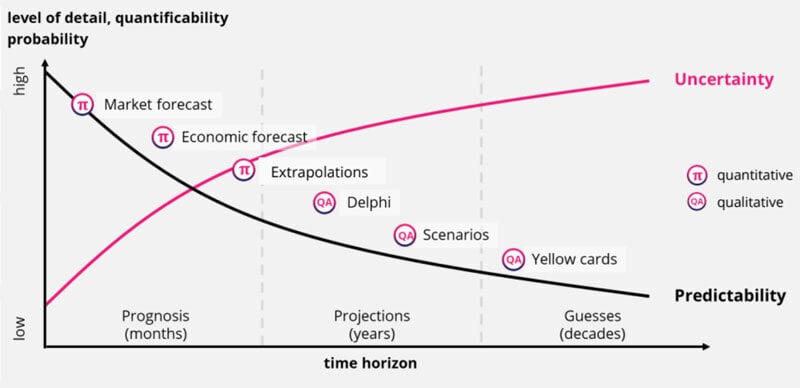
Exhibit 1: Fundamentals of the future
Considering the above, scenario planning incorporates a balance of both quantitative and qualitative approaches to develop projections and gain perspective over a longer time horizon.
What is a scenario
By definition, a scenario—in the context of business planning and strategy—is a postulated sequence or combination of events projected to take place that could hold relevance to the organization’s future state (Exhibit 2).
While a mid- to long-term perspective holds greater uncertainty, myopic management decision-making based solely on historical and current data puts organizations at risk of complacency or even obsolescence. Where traditional planning provides a detailed map describing constant elements of the environment, scenario planning takes one step further by considering variable data to arrive at plausible projections.
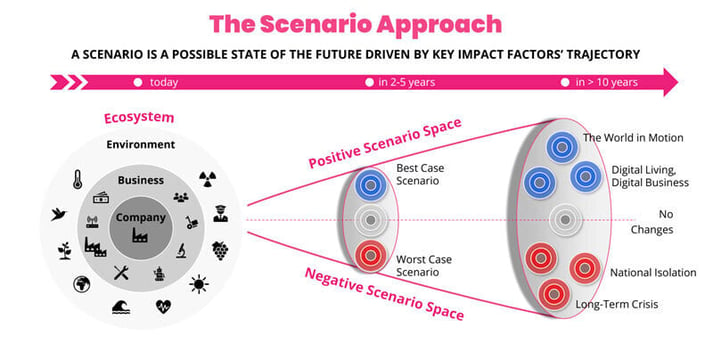
Exhibit 2: The scenario approach
The building blocks for scenarios
In scenario planning, Drivers of Change (such as technological, economic, or social forces) lay the foundation by identifying what shapes the organization’s environment. From these drivers, Basic Trends emerge as predictable directions of change, while Key Uncertainties represent the unpredictable factors that could impact the future in different ways. Through Rules of Interaction, these trends and uncertainties are analyzed together, illustrating how they might influence each other. This process generates Multiple Scenarios—distinct versions of the future that help organizations explore a range of possibilities and develop resilient strategies (Exhibit 3).
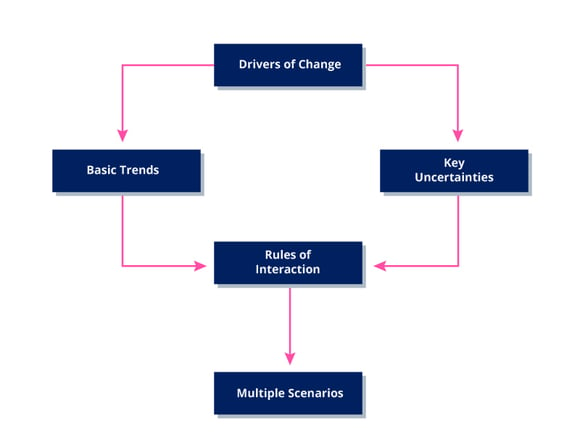
Exhibit 3: Building blocks for scenarios
What is scenario planning
Scenario planning is a strategic tool commonly used by key decision-makers, innovation leads, and strategists to find focused foresight—grounded in dependable analysis. This equips them to anticipate exposures appropriately, evaluate innovation opportunities and inform proactive responses.
By defining critical uncertainties, the scenario planning process considers variable data trajectories to arrive at a limited number of possible states and provide a wider range of possible eventualities as the basis for decision-making. Each plausible scenario provides a narrative that enables strategists to imagine and assess the impacts various outcomes may have on their organization.
As a story of how various elements might interact under certain conditions, scenarios allow strategists to better formulate predictions of relationships between elements. Evaluated for internal consistency and plausibility, this analysis provides a structured methodology to quantify qualitative perspectives and address only that which is logically possible and likely to happen.
This provides organizations with the information required to act timeously and the evidence needed to develop appropriate capabilities and assets, actively shape our world, and influence outcomes as they steer toward the future.
The importance of scenario planning to future-proof strategy
In today’s competitive and volatile business landscape, resilience and future-proofing have become the prerequisites for success. While there’s no crystal ball for knowing what’s ahead—and, importantly, how to respond—scenario planning can produce detailed and realistic narratives about the future. And these outcomes can be used to identify opportunity spaces in which to play, help best prepare an organization for the future, and ultimately direct its strategy.
Here are four ways in which scenario planning works to future-proof strategy:
1. Ensure company viability
By following a systematic approach with an expanded perspective of what might happen in its future environment, an organization can detect potential opportunities and threats. Pre-emptive preparation in response helps build organizational resilience and clears a path for future growth.
2. Understand the future environment
An organization’s future business environment is informed by the key factors influencing its current environment. These may be drivers, trends, technologies, customer needs, etc. Extrapolating these to scenarios requires organizations to consider and assess the likelihood of an observed trajectory continuing or changing course.
3. Prepare for the future
Scenario planning helps organizations widen their scope and mitigate the risk that can arise from preparing for only one possible scenario. Inherent in the process is the need to challenge the overconfidence and tunnel vision that can limit decision-making efficacy. Instead, understanding and preparing for multiple scenarios strengthens strategic robustness.
4. Shape the future
Gaining strategic advantage increasingly relies on an organization’s ability to not only prepare for the future but to also play an active role in shaping and improving it for all stakeholders. Future scenarios act as the playing field on which organizations can define their strategic options, initiatives, and actions for the future—and therefore drive the ecosystem into desired directions.
Delivering on these benefits requires a clear framework for scenario planning, a commitment to the process, and the openness to embrace different worldviews.
When to use scenario planning
Essentially, people can use scenario planning techniques as a strategy tool to inform decisions at any level—individual, function, group, or organization. It is considered to be most beneficial in constructing a clear, corporatewide vision of the future; in this way, a future-back approach can be applied in strategic planning. Organizations that are confronted with the following circumstances are positioned to receive the greatest benefit from the scenario planning exercise:
- High uncertainty: There is a high level of uncertainty relative to the decision maker's ability to predict or adjust to future events.
- Material risk: The implications of unexpected events put the company at material risk and hold a high cost.
- Lack of opportunities: The organization does not have a clear perception of new opportunities on the horizon.
- Business-as-usual mindset: Business-as-usual dominates strategic thinking, and the organization is locked down in operationalized routines.
- Industry disruption: The industry in which an organization is operating has experienced significant change, is expected to evolve, or is susceptible to disruption.
- Need for consensus: A common language and consensus are required to drive action without stifling collaborative and diverse perspectives.
- Diverse alternatives: There are several alternatives available, constructed through diverse perspectives, each holding valuable merit.
- Competitor resilience: Competitors have demonstrated resilience and show signs of making use of scenario planning techniques at a strategy level.
Scenario planning techniques can be applied to any situation in which a decision-maker needs to better understand how the future might unfold under particular circumstances. In this article, we focus on developing scenarios for strategic planning. However, the methodology applies to any situation that requires objective decision-making when there is a greater risk of exposure to uncertainty.
4 key steps in the scenario planning process
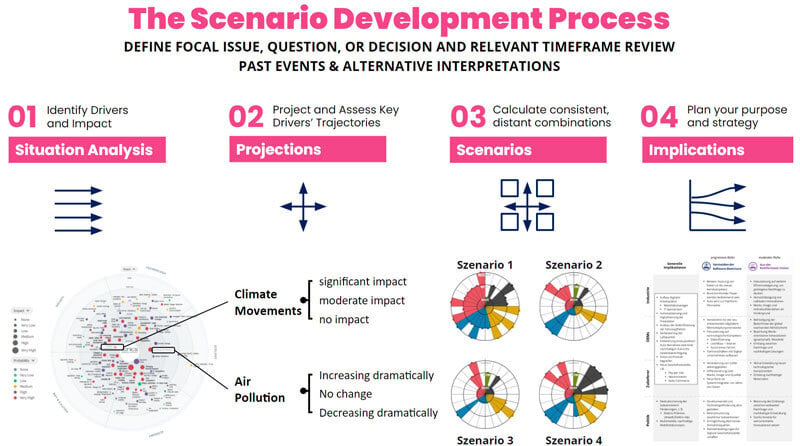
Exhibit 4: The scenario development process
1. Situation analysis: Identify drivers and impact
A multitude of drivers exist and have an impact across all STEEP categories—Society, Technology, Economic, Environment & Ecology, and Politics & Law.
Organizations must first narrow their scope, performing situation analysis to select the drivers that are of the highest importance to their business environment. Teams can assess and rate drivers based on level of impact, probability, and/or reach. The ability to visualize all drivers in a single view enables the quick comparison and identification of those that hold relevance for an organization’s scenario planning.
Drivers are environmental factors that influence the situation of a business. This includes existing influence factors as well as observable changes toward something new and future-relevant. Demand drivers are driving forces in society or in the market that point in a certain direction, representing and affecting individuals’ and/or customers’ wishes, desires, and behaviors (e.g., Trends). Solution drivers are new or existing means, methods, tools, and/or capabilities that can practically solve certain problems and are future-relevant (e.g., Emerging Technologies).
2. Projections: Project and assess key drivers' trajectories
Once an organization has explored and selected the key drivers influencing its environment, it must identify critical uncertainties and extrapolate the different plausible possibilities that could unfold for each driver. The time horizon that should be considered is between five to ten years (compared with the two- to five-year outlook that Trends and Emerging Technologies offer).
Scenario planners must project the trajectory that each driver could take—typically ranging from one extreme to the other, e.g., no impact to significant impact, decreasing dramatically to increasing dramatically, system collapse to system transformation, etc.
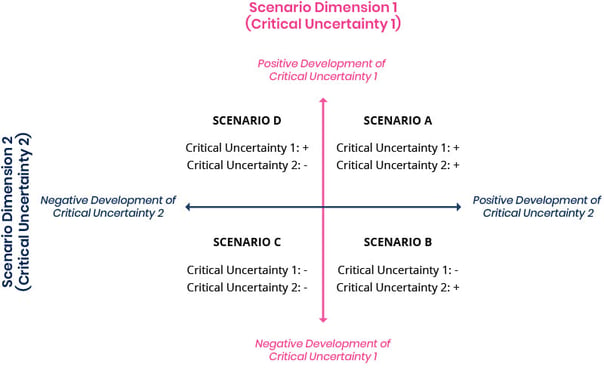
Exhibit 5: Scenario dimension matrix
3. Scenarios: Calculate consistent, distant combinations
To develop future scenarios, two selected drivers (e.g., a demand driver and a solution driver) must be plotted against each other, with the respective trajectories along each axis. For instance, an organization could plot industry-relevant technological development along the X-axis and a driver such as regulation, globalization, or environmental degradation along the Y-axis.
Intersections between trajectories reveal different scenarios. When this process is replicated for various combinations of drivers, several scenario narratives should arise. While all represent a possible future for which an organization may need to prepare, internal consistency points to scenarios that are most likely to happen and should be prioritized in the next steps.
High internal consistency points to plausible scenarios and must be assured across three dimensions:
- Trends and emerging technologies: Are the trajectories of selected trends and emerging technologies compatible with the time frame informing scenario planning?
- Combinations of drivers: Do the combinations of drivers produce logical outcomes that do not present contradictions?
- Major stakeholders: Are there major stakeholders (e.g., governments, international organizations) who hold global influence to change an unfavorable future scenario?
Performing these tests for internal consistency will help further prioritize the scenarios to explore further.
4. Implications: Plan your purpose and strategy
An organization must select the most plausible scenarios to use in opportunity discovery and strategy planning. In addition to looking for internal consistency, an organization's internal stakeholders can also assess and rate scenarios, e.g., based on desirability, strategic alignment, and impact. As with trend and driver selection, this helps increase transparency, consensus, and ultimately informs opportunity space creation. An opportunity space—which represents several possible solutions—exists where a selected scenario, reinforced by present-day market evidence, meets an organization’s purpose and strategy.
Digital roadmaps
Plot your organization’s responses to selected scenarios and opportunity spaces on the ITONICS Roadmap. Digital roadmaps help teams identify the key technologies and resources needed for product or technology development as well as synergies and time inconsistencies within strategy planning for the future.
→ Free Webinar & Playbook: How to Get From Scenarios to Roadmaps
How to get started with scenario planning
Now you know everything about the principles of scenario planning. To get started in practice, we recommend the following steps:
1. Build a team for collaborative participation
Diverse perspectives are fundamental to the success of the scenario planning process. To gain greater strategic buy-in across the organization, it is recommended that you invite six to twenty bright individuals to participate throughout this process, including stakeholders from outside the organization.
Invites can be extended to suppliers, customers, regulators, board members, analysts, or academics to gain a holistic view of what is strategically relevant within the project’s scope.
2. Clarify, define, and communicate the scope of your project
As an essential step to the process, the project scope provides the lens through which teams can explore the environment, identify trends and emerging technologies and subsequently identify the drivers of change most relevant to the organizations’ innovation objectives.
3. Rate and evaluate trends and emerging technologies
Explore each trend and emerging technology, and rate them on the following criteria in line with the scope of the project and innovation objectives:
Trends:
- Business Relevance: How relevant is this element to your business?
- Strategic Fit: How well does this element fit into your organization’s overall strategy?
- Need for Action: How important is it that your organization take action with regard to this element
Emerging technologies:
- Technology Attractiveness: How high is the potential value of the technology?
- Internal Know-How: How much internal know-how does your business possess with regard to this element?
- Need for Action: How important is it that your organization take action with regard to this element?
Also see: How to Identify Relevant Trends and Technologies for Your Organization
4. Identify relevant trends and emerging technologies to uncover key drivers
Explore each trend and emerging technology, and assess the forces shaping the future to uncover the key drivers at play. Rely on your team to reach a consensus on what these are in order to move forward. A simple clustering exercise can arrive at fundamental themes and point to the uncertainties that should be explored in scenario analysis. However, teams that need to account for a high number of key drivers can better arrive at an agreed view by creating a dedicated key driver radar, which will allow for collaborative rating.
To uncover the key drivers and uncertainties to address, teams should consider the following dimensions:
- Degree of Impact (significant/minimal)
- Velocity of Change (increasing/decreasing)
5. Plot key drivers against one another on a grid to derive multiple scenarios
Once the key drivers are set against one another, engage the team’s collective input to imagine and extrapolate multiple outcomes. Untangle the external issues, drivers, and uncertainties and repackage them into broad-ranging and fundamentally different scenarios.
The recombination of the key drivers can be done in at least three different ways:
- Intuitively: once all the pieces are seen from a helicopter view, teams can cluster ideas to identify key themes and storylines to organize all the elements.
- Heuristically: selected using evaluation and rating criteria.
- Statistically: systematically combine the outcomes of all the key uncertainties into internally consistent combinations to find feasible results.
It is imperative to ensure that all outcomes are indeed internally consistent—that is, plausible and likely to happen. At this stage, it is helpful to investigate story-telling techniques to deliver a clear narrative of how the future might unfold under each scenario.
6. Select relevant scenarios for further analysis based on innovation objectives
The team should select the scenarios they feel hold the most strategic relevance by asking themselves the following two questions:
- Is this a future we hope to play an integral role in creating and shaping?
- Is this a future we hope to mitigate and avoid through thoughtful tactics?
Thereafter, further analysis of the scenarios can help unravel the potential events that may play out into the future. These eventualities can be plotted against a timeline or on the ITONICS Roadmapping tool to assist teams in understanding how they might be addressed.
7. Derive opportunity spaces as a response to the various scenario narratives
To engage in detailed scenario planning in your company, you may want to convene a one- or two-day scenario workshop in which the focus is on responding to the various potential events extrapolated into the future. Based on the selected scenarios, this forms a foundational springboard from which organizations can best derive and define clear opportunity spaces.
Workshops
Be sure to gain an outside-in perspective in these workshops to open up greater opportunities for imaginative and playful thinking in a psychologically safe space. In this divergent phase of creative thinking, teams should avoid evaluating any potential ideas and/or solutions.
8. Table opportunity spaces for strategic buy-in and selection
Each opportunity space should be elaborated on in detail to demonstrate a clear understanding of the business case it holds while also indicating the evidence on which the response is based. Teams can gain requisite buy-in at C-level by inviting additional evaluation and selection based on the following criteria:
- Market Attractiveness
- Strategic Fit
- Feasibility / Ability to Execute
This rating will provide a clear portfolio from which organizations can select the opportunities they hope to pursue.
9. Plot a clear roadmap to drive exploration of opportunity spaces through R&D
Use the ITONICS Roadmapping tool to plot out the critical scenario events and work backward to develop a timeline of innovation activities required to explore the various opportunity spaces timeously, ahead of the horizon in which they are set to occur.
Your digital software tool for scenario planning
Effective scenario planning requires the ability to identify how external forces of change will impact your industry and create risks and opportunities for your organization.
This process requires collaborative engagement, management buy-in, a constructive roadmap, and an ongoing conversation to overcome skepticism and ensure strategic alignment and commitment to execution.
The ITONICS Innovation OS is a software solution that helps organizations to systemize all activities from strategy to execution, at scale. You can use ITONICS to model future scenarios, collaborate with relevant stakeholders, share insights, and make data transparent on one central digital platform.
- Use ITONICS Radar to assess and rate drivers of change together with your team or even external experts. Visualize their level of impact, probability, and reach, then identify those most critical and influential to your future. Narrow down to focus on the drivers of change that will give you the most valuable insight into the future.
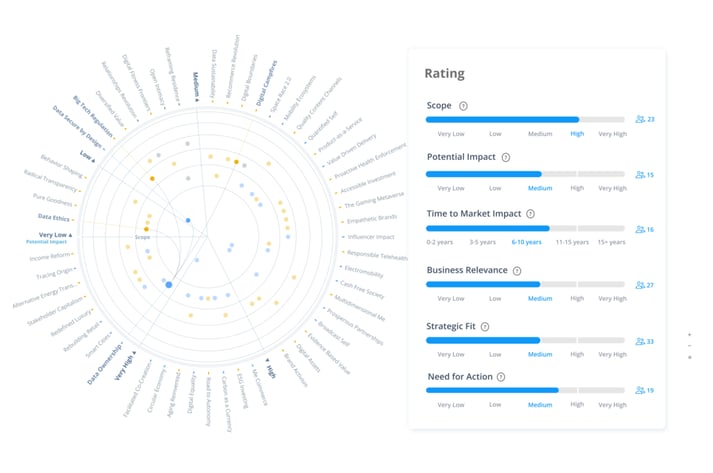
Exhibit 6: Radars visualize the level of impact, profitability, and reach of drivers of change
- Use ITONICS Matrix to plot possible futures. Determine the critical nature of each scenario based on potential impact (Exhibit 7). Use the Matrix view to visualize the priority level and highlight strategic focus areas for the business. Focus on the scenarios most critical to future success.
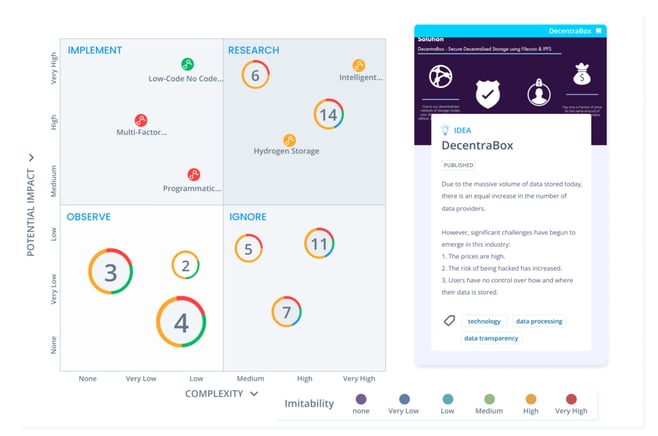
Exhibit 7: Matrices plot possible future scenarios
- Use ITONICS Roadmap to visualize potential futures by indicating key events along clear and realistic timelines. Use these pathways to identify the related actions to take to achieve the most desirable outcome. You could call this “Agile Backcasting” to identify the right time to take action.
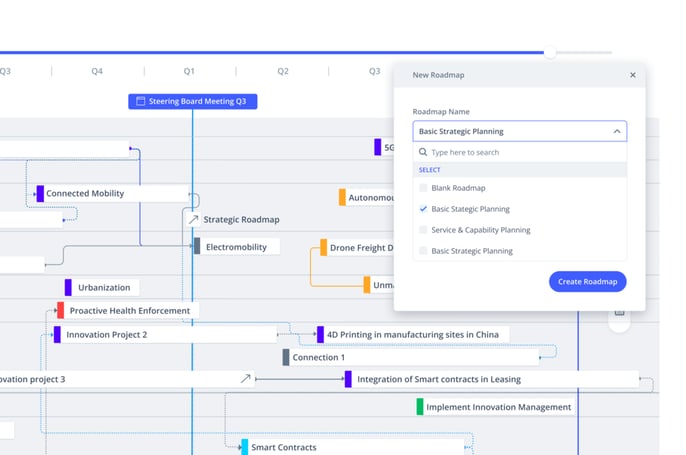
Exhibit 8: Roadmaps translate strategy into business deliverables for growth
If you want to learn more about the features and functionalities of the ITONICS Innovation OS to enhance your strategic foresight capabilities, get a free demo!
FAQs on scenario planning
Which software supports scenario-based innovation planning?
ITONICS supports scenario-based innovation planning with integrated tools for environmental scanning, trend evaluation, and collaborative roadmap building. The platform enables teams to map alternative futures and align innovation initiatives accordingly.
How does ITONICS help organizations visualize alternative future scenarios?
ITONICS provides configurable foresight tools like Trend and Technology Radars, Impact Matrices, and Roadmaps, allowing teams to structure scenario narratives, assess uncertainties, and link future developments to strategic actions.
What role does collaboration play in scenario planning with ITONICS?
Scenario planning in ITONICS is supported by real-time collaboration features, enabling diverse teams and stakeholders to co-create, evaluate, and iterate on future scenarios within a centralized platform.




